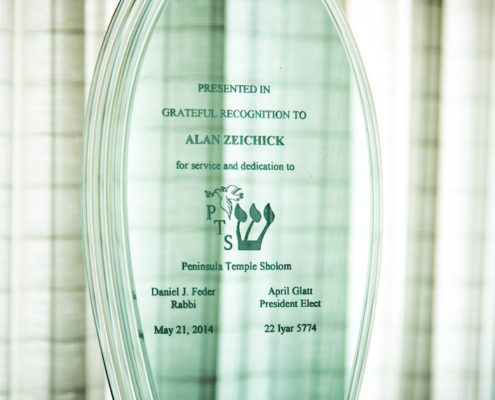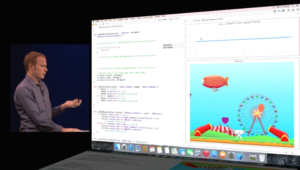 This is one of a series of articles I wrote for the monthly Bulletin of Peninsula Temple Sholom in Burlingame, Calif.
This is one of a series of articles I wrote for the monthly Bulletin of Peninsula Temple Sholom in Burlingame, Calif.
The Moving Finger writes; and, having writ,
Moves on: nor all thy Piety nor Wit,
Shall lure it back to cancel half a Line,
Nor all thy Tears wash out a Word of it.
— Omar Khayyám (1048-1131)
My favorite part of the b’nai mitzvah ceremony at PTS is the l’dor vador presentation of the sacred Torah. From grandparent to grandparent, from grandparent to parent, from parent to parent, from parent to child, we pass down our most treasured symbol, and with it, we pass along our hopes, our dreams and our roles. The l’dor vador is beautiful to watch. It’s even more beautiful, and even more touching, when you receive the Torah from your parents, and then hand it off to your own child, as Carole and I did in December 2006.
Michael’s becoming a bar mitzvah, a son of the commandment, was truly a liminal moment. A time of significant change. An inflection point. Our lives would never be the same after that.
We are at another inflection point, probably one that means more to me than to you. My term as President of the Board of Trustees ends on June 30. Wow. So much has changed and evolved in this kehila kedosha, this blessed community. As the torch of lay leadership moves on, we are experiencing many liminal moments at Peninsula Temple Sholom. Let me share some of them with you.
Changes to our clergy team. As you know, Rabbi Rebekah Stern heads across the Bay on July 1. The hard-working Rabbinic Search Committee, co-chaired by past president Keith Tandowsky and by board vice-president Lauren Schlezinger, remains hard at work. As of this column due date (early May), the search is still ongoing. Like you, I am a little antsy, but am confident that the process will result in an excellent clergy plan for our PTS community.
A new title for Allison Steckley. Allison’s first year at PTS as a preschool teacher was the same year that Michael started preschool. Allison followed Cindy Common and Bobbie Goldstein as Preschool Director – and the board recently upgraded Allison’s title to Director of Early Childhood Education. Under Allison’s leadership, and thanks to her vision, the Preschool goes from strength to strength.
Transitioning of Brotherhood. It’s a sad reality, but congregational participation in Brotherhood has declined significantly over the past few years. In April, the Brotherhood board voted to suspend activities as a Temple auxiliary as of June 30. Let me thank everyone who participated in Brotherhood for their myriad contributions to PTS, and especially acknowledge president Alex Wilkas, treasurer Michael Battat and immediate past president Habib Lichaa for their incredible hard work, commitment and leadership.
Creation of a new Caring Community program. We heard many messages in our Kolot conversations, and one is that many congregants need more personal support from the PTS than the leadership has realized. I am thrilled that board member Linda Korth is heading a task force to reimagine the Caring Community at PTS as part of our Sukkat Shalom. Linda is working closely with Rabbi Dan Feder, executive director Sandy Silverstein, and many others. Look for exciting news to come out about Caring Community over the past year, along with ways for you to participate.
Spiritual Center and Chapel renovation. The new Jack & Candee Klein Spiritual Center, will be a complete reinvention of three rooms, currently known as the chapel, the corner room and the computer lab. (The corner room will be remodeled and become the new Lent Chapel.) This miracle is due to the incredible generosity of the Jack and Elisa Klein Foundation – thank you! The construction will happen this summer and the new space will completed before Preschool and Religious School open in the fall. Let me thank past president Diane Goldman, who is chairing the project, and everyone involved, for their amazing work.
Continuing evolution of Kolot. The Kolot Steering Committee, co-chaired by board member Heidi Schell and by Neal Tandowsky, has already launched Phase II of the Kolot (“Voices”) project. Working together with Sister Judy Donovan and Joaquin Sanchez from the Industrial Areas Foundation, we are becoming closer as a community — and discovering what our common values are. (See the comments above about the Caring Community as one of the first fruits of Kolot.) We are going places, and we will make a difference.
Fresh lay leadership for PTS. The 2014-2015 Board of Trustees takes office on July 1 under incoming president April Glatt. This temple has an incredibly wonderful and dedicated board, and April is a blessing. It been an honor to contribute to the PTS board, which I joined 2007, under presidents Karen Wisialowski, Keith Tandowsky and Brian Hafter. All three have been my mentors and my role models. Thank you, Karen, Keith and Brian, for your leadership, and for providing me with this opportunity to serve.
Transitions for the Zeichick family. In July, Carole and I will move to Phoenix. This brings us much closer to our son Michael (who is stationed at Twentynine Palms, Calif.) and to our many cousins who live in the area. After 25 years in the Bay Area, we are ready for new adventures and for high-temperature fog-free living. We aren’t disappearing entirely: Carole and I will visit PTS whenever we come back for business and pleasure. We also hope to see you when you go to Scottsdale for Giants spring training or otherwise visit the Valley of the Sun.
Thank you, thank you, dear friends
This is where I say thank you to all the past presidents, who have shown us so much kindness; to everyone I have served with on the board; to Rabbi Dan Feder, Rabbi Rebekah Stern and Cantor Barry Reich; to Sandy Silverstein, Allison Steckley and Eran Vaisben; to all the hard-working Temple staff; to all committee chairs and members; to every volunteer and donor; and to everyone Carole and I have prayed with, studied with, worked with, shared a meal with, mourned with and laughed with. You are all b’tzelem elohim, created in the image of God.
Dear friends, Peninsula Temple Sholom has been our spiritual home for many years. You have provided us with a shelter of peace, and given Michael a wonderful Jewish education and solid moral center. For that we shall always be grateful. Our love for this sacred community will endure forever.
Yevarechecha adonai veyishmerecha. Ya’er adonai panav elecha veyichunecha. Yisa adonai panav elecha veyasem lecha shalom.
May God bless you and keep you. May the light of God shine on you and be gracious to you. May the presence of God be lifted over you and may God bless you with peace.
 GOOGLE I/O 2004, SAN FRANCISCO — What is Android? It’s hard to know these days, and I’m not sure if that’s good or not. We all know what happened when Microsoft began seeing Windows as a common operating system for everything from embedded systems to desktops to phones to servers. By trying to be reasonably good at everything, Windows lost its way and ceased being the best platform for anything.
GOOGLE I/O 2004, SAN FRANCISCO — What is Android? It’s hard to know these days, and I’m not sure if that’s good or not. We all know what happened when Microsoft began seeing Windows as a common operating system for everything from embedded systems to desktops to phones to servers. By trying to be reasonably good at everything, Windows lost its way and ceased being the best platform for anything.
 Are you covered by a non-compete agreement at your current employer? Are your workers covered by a non-compete? While non-competes may make your executives (and their attorneys) feel good, they may not be good for your company.
Are you covered by a non-compete agreement at your current employer? Are your workers covered by a non-compete? While non-competes may make your executives (and their attorneys) feel good, they may not be good for your company. Two consulting projects this year have involved lots and lots of data. One was the migration of a very complex customer database and transaction logging system to a cloud-based CRM platform from a homegrown system. The other involved performing serious analytics on a non-profit’s membership system that had data spanning decades.
Two consulting projects this year have involved lots and lots of data. One was the migration of a very complex customer database and transaction logging system to a cloud-based CRM platform from a homegrown system. The other involved performing serious analytics on a non-profit’s membership system that had data spanning decades. SAN FRANCISCO — I expected a new version of OS X, the operating system for Mac desktops and notebooks. I expected a new version of iOS, the operating system for iPhones and iPads. I did not expect a new programming language. Yet that’s what we got at Apple’s
SAN FRANCISCO — I expected a new version of OS X, the operating system for Mac desktops and notebooks. I expected a new version of iOS, the operating system for iPhones and iPads. I did not expect a new programming language. Yet that’s what we got at Apple’s  This is one of a series of articles I wrote for the monthly Bulletin of
This is one of a series of articles I wrote for the monthly Bulletin of